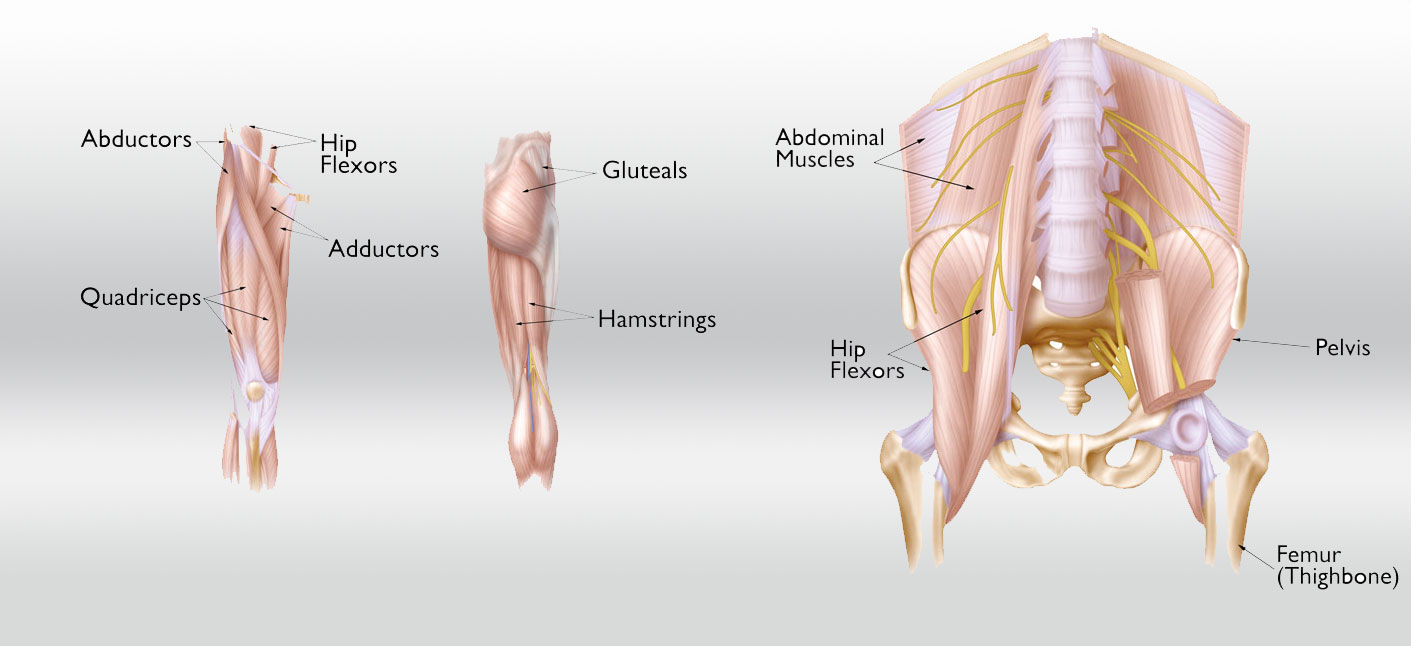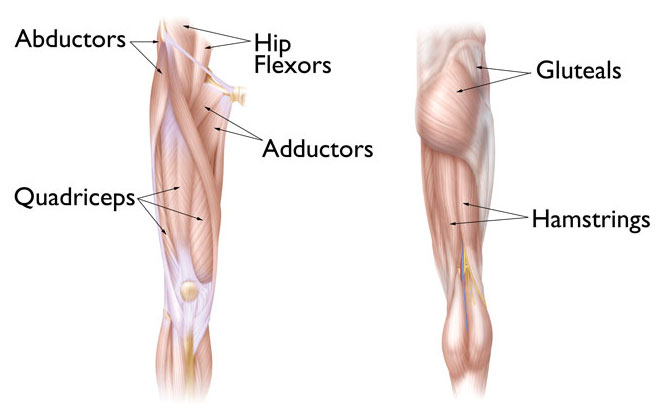Hip strain: Description, Causes, Treatment

Hip Strain
A hip strain occurs when one of the muscles supporting the hip joint is stretched beyond its limit or torn. Strains may be mild, moderate, or severe, depending on the extent of the injury. A severe strain can limit your ability to move your hip.
Anyone can experience a hip strain just doing everyday tasks, but strains most often occur during sports activities.
Although many hip strains improve with simple home treatment, severe strains may require physical therapy or other medical treatment.
Description
The large bones that make up the hip joint—the femur (thighbone) and the pelvis—serve as anchors for several muscles. Some of these muscles move across the abdomen or the buttocks (hip flexors, gluteals). Others move down the thigh to the knee (abductors, adductors, quadriceps, hamstrings).
The lower abdominal muscles and hip flexor muscles are often involved in a hip strain.
 In a hip strain, muscles and tendons may be injured. Tendons are the tough, fibrous tissues that connect muscles to bones. Hip strains frequently occur near the point where the muscle joins the connective tissue of the tendon.
In a hip strain, muscles and tendons may be injured. Tendons are the tough, fibrous tissues that connect muscles to bones. Hip strains frequently occur near the point where the muscle joins the connective tissue of the tendon.
The strain may be a simple stretch in your muscle or tendon, or it may be a partial or complete tear of muscle fibers or of the muscle and tendon combination.
Once the muscle is injured, it becomes vulnerable to reinjury. Repeated strains in muscles about the hip and pelvis may be associated with athletic pubalgia (also called sports hernia). A sports hernia is a strain or tear of any soft tissue (muscle, tendon, ligament) in the lower abdomen or groin area. This condition is discussed in Sports Hernia (Athletic Pubalgia).
Cause
A hip strain can be an acute injury—meaning that it occurs suddenly, such as from a fall or a direct blow during contact sports. Hip strains are also caused by overuse—when the muscle or tendon has slowly become weakened over time by repetitive movements.
Factors that put you at greater risk for a hip strain include:
- Prior injury in the same area
- Muscle tightness
- Failure to warm up properly before exercising
- Attempting to do too much, too quickly, when you exercise
Symptoms
 A muscle strain causes pain and tenderness in the injured area. Other symptoms may include:
A muscle strain causes pain and tenderness in the injured area. Other symptoms may include:
- Increased pain when you use the muscle
- Swelling
- Limited range of motion
- Muscle weakness
Home Remedies
Many hip strains will improve with simple home treatment. Mild strains can be treated with the RICE protocol. RICE stands for rest, ice, compression, and elevation.
- Rest. Avoid activities that put weight on the hip for the first few days after the injury.
- Ice. Apply ice immediately after the injury to keep the swelling down. Use cold packs for 20 minutes at a time, several times a day. Do not apply ice directly on the skin.
- Compression. To prevent additional swelling, lightly wrap the area in a soft bandage or wear compression shorts.
- Elevation. As often as possible, rest with your leg raised up higher than your heart.
In addition, non-steroidal anti-inflammatory drugs, or NSAIDs, such as ibuprofen and naproxen, can help reduce swelling and relieve pain.
If the pain persists or it becomes more difficult to move your hip and leg, contact your doctor.
Doctor Examination
Physical Examination
Your doctor will discuss your general health and ask you about what activities you were doing just prior to the injury. He or she will examine your leg and hip for tenderness or swelling. During the physical examination, your doctor will apply pressure to various muscles in the area and move your leg and hip in various directions to assess your range of motion.
Your doctor may also ask you to perform a variety of stretches and movements to help determine which muscle is injured.
X-Rays
X-rays provide images of dense structures such as bone. Your doctor may order an x-ray to rule out the possibility of a stress fracture of the hip, which has similar symptoms. In most cases, no additional imaging tests are needed to confirm the diagnosis.
Treatment
Medical treatment for muscle strains is designed to relieve pain and restore range of motion and strength. The majority of hip strains are treated nonsurgically.
Nonsurgical Treatment
In addition to the RICE method and anti-inflammatory medication, your doctor may recommend using crutches for a few days to limit the weight on your hip. Other recommendations may include:
- Heat therapy. Ice should be applied immediately after an acute injury to reduce swelling. After 72 hours, however, alternating ice with heat therapy—which may include soaking in a hot bath or using a heat lamp or heating pad—may help relieve pain and improve range of motion.
- Home exercise program. Specific exercises can strengthen the muscles that support the hip and help to improve muscle endurance and flexibility.
- Physical therapy. If pain persists after a few weeks of home exercise, your doctor may recommend formal physical rehabilitation. A physical therapist can provide an individualized exercise program to improve strength and flexibility.
Surgical Treatment
Severe injuries in which the muscle fibers are completely torn may require surgery in order to return to normal function and movement. Surgery typically involves stitching the torn pieces back together.
Many severe hip strains are successfully treated without surgery. Your doctor will discuss the treatment options that best meet your individual health needs.
Recovery
In most cases, you should avoid the activity that caused your injury for 10 to14 days. A severe muscle strain may require a longer period of recovery. If your pain returns when you resume more strenuous activity, however, discontinue what you are doing and go back to easier activities that do not cause pain.
You can take the following precautions to help prevent muscle strains in the future:
- Condition your muscles with a regular program of exercise. Ask your doctor about exercise programs for people of your age and activity level.
- Warm up before any exercise session or sports activity, including practice. A good warm up prepares your body for more intense activity. It gets your blood flowing, raises your muscle temperature, and increases your breathing rate. Warming up gives your body time to adjust to the demands of exercise. It increases your range of motion and reduces stiffness.
- Wear or use appropriate protective gear for your sport.
- Take time to cool down after exercise. Instead of performing a large number of rapid stretches, stretch slowly and gradually, holding each stretch to give your muscle time to respond and lengthen. You can find examples of stretching exercises in the Related Resources section of this article or ask your doctor or coach for help in developing a routine.
- Take the time needed to let your muscle heal before you return to sports. Wait until your muscle strength and flexibility return to preinjury levels.
BoulderCentre can help. Call us (303) 449-2730 and ask to see one of our hip and knee specialists.
Article courtesy of AAOS: American Academy of Orthopedic Surgeons.





